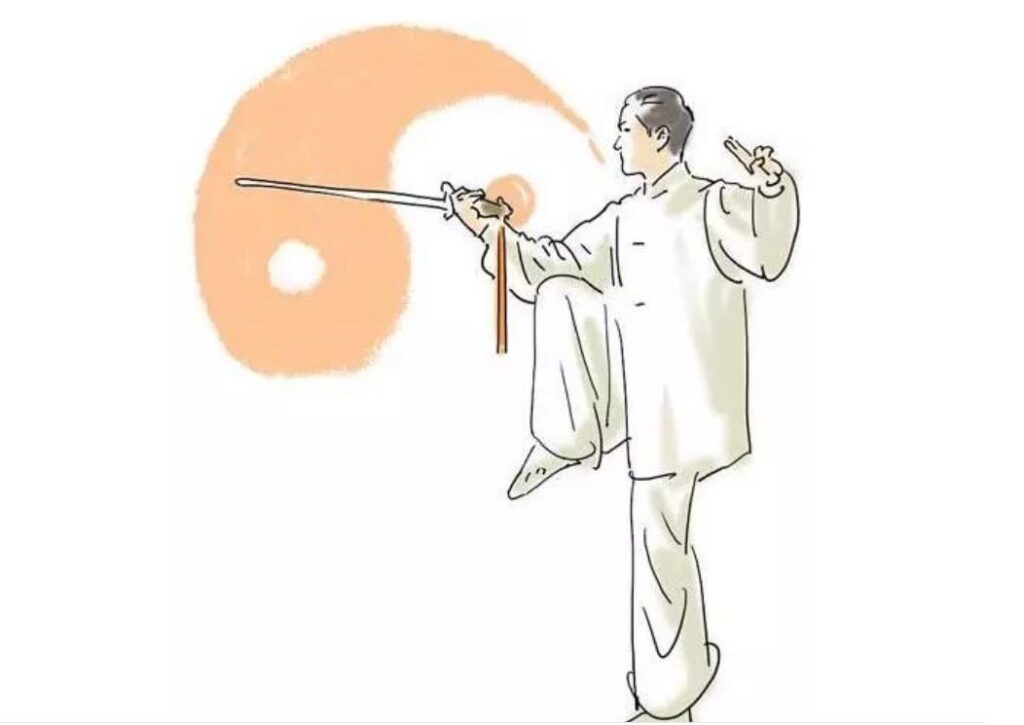
Tai Chi swordplay uses the sword in the hand as a weapon, gathering the energy of the two poles of yin and yang. Regardless of the weight of the sword, it can be moved far and near freely. Tai Chi swordplay is very rich, and the names of the movements are not completely unified, but they are all based on the four types of swordplay: striking, stabbing, blocking, and washing.
Tai Chi sword play mainly includes 13 types of swordplay: pointing, stabbing, chopping, sweeping, dragging, pulling, intercepting, wiping, lifting, striking, hanging, supporting, and blocking.
(1) Pointing the sword:
The hand holding the sword uses the wrist to exert force, focusing the force on the tip of the sword, and uses the front part of the sword blade on the opposite side of the tiger’s mouth to peck from top to bottom. It mainly attacks the opponent’s wrist or shoulder arm holding the sword, such as the “pointing the sword with a step” style and the “pointing the sword with a step” style.
(2) Stabbing the sword:
Use the legs, waist and arms to exert force, focusing the force on the tip of the sword, and use the tip of the sword to directly pierce the opponent’s vital parts. If classified by the shape of the sword, there are horizontal thrusts (sword spine upward or downward, blade horizontal to both sides), vertical thrusts (blade upward or downward), thrusts (rotating the wrist to apply force, so that the tip of the sword spirals forward), etc. If classified by the position of the sword, there are upward thrusts, downward thrusts, oblique thrusts, reverse thrusts, etc.
(3) Sword chopping:
The waist and the entire arm exert force, and the force reaches the middle and front part of the blade on the side opposite to the base of the thumb, and the force is applied from top to bottom. Such as the “independent swing chopping” style and the “reverse chopping” style.
(4) Sword sweeping:
The palm faces upward, the sword body is flat, and the sword blade is swept from one side to the other at a low level with the power of the waist. The range of movement is large, and it is an action to attack the lower body.
(5) Sword sweeping:
It is an action of using defense as offense. The forearm rotates outward or inward, and the force is applied to the outer blade, so that it is pulled from front to back or diagonally. Such as the “rightward horizontal swing” style and the “turn and diagonal swing” style.
(6) Sword drawing:
It is a defensive action. Bend the elbow joint, with the force on the blade, and use the blade to draw back from front to back or left to right. Such as “step back and draw back” and “turn around and draw back”.
(7) Sword interception:
It is a defensive action. Use the arm and wrist to apply force, and the force point is transferred from the back end or middle section of the blade to the front, which has the effect of cutting or chopping. Such as “empty step down interception”.
(8) Sword wiping:
Defend and attack. Use the blade to wipe horizontally from front to back or from left to right, with the force on the blade. Such as “rotating flat wiping”.
(9) Sword lifting:
It is an offensive action. Use the middle section or front end of the blade on the opposite side of the tiger’s mouth to apply force, pull the wrist upward, and move from bottom to front or upward to lift and cut. Such as “left empty step lifting” and “right bow step lifting”.
(10) Fencing:
It is an offensive action. With the palm facing upward, strike forward with the tip of the sword blade on the side facing the base of the sword, with the force concentrated on the front end of the sword. Such as the “step back and counterattack” style.
(11) Hanging the sword:
It is a defensive action, which can be left or right. The base of the sword holding hand exerts force backward, with the force reaching the tip of the sword, hooking it back from front to back, and hanging it back to the right (left) lower part of the body.
(12) Supporting the sword:
It is an offensive and defensive action. Extend the upper arm and use the sword body (blade) to support it from bottom to top, with the force point being the middle and back sections of the sword blade. Such as the “independent flat support” style.
(13) Blocking the sword:
It is a defensive action. Use the sword blade to push forward from back to front, or push from bottom to top. Such as the “right bow step blocking” style.
